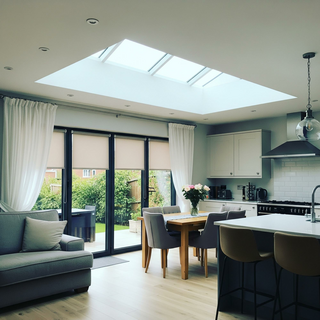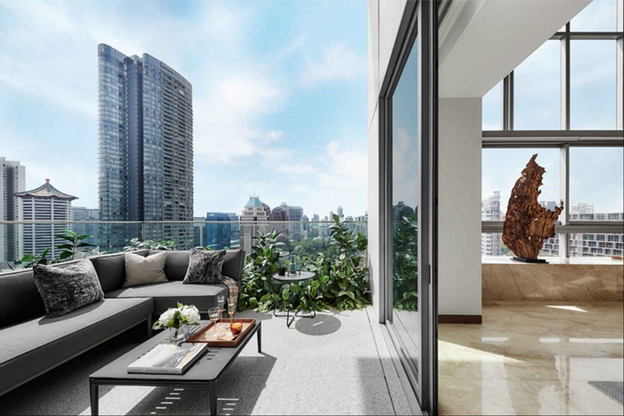
Open-plan living has become one of the most popular layouts in UK homes over the past decade. Kitchens that merge into dining and living areas allow families to cook, relax, socialise and entertain in one flowing space. These rooms feel more modern, more sociable and more connected to the rest of the home. Yet open-plan layouts also demand careful consideration of light management and visual balance. When you remove walls, you also remove natural divisions, and this affects how windows perform and how comfortable the room feels throughout the day.
Understand the Purpose of Each Zone
Even in open-plan layouts, the room still needs structure. It helps to mentally divide the space into zones: cooking, dining, relaxing, working or reading. These don’t have to be rigid boundaries, but it is worth being aware of where activities naturally fall. Softer flooring like rugs, strategic furniture placement and changes in lighting levels can help guide how each part of the room feels and behaves.
Why Windows Matter More in Open-Plan
One of the significant strengths of open-plan living is the increase in sightlines. Once walls are removed, windows become more visible from multiple angles. This means your window treatments don’t just affect one room — they can impact your entire ground floor. Too heavy or too dark, and you risk pulling the space down. Too sheer, and you may not get enough privacy come evening.
Consider Layered Window Treatments
Layering allows you to adapt to changing light. Sheers are excellent for daytime softness, particularly if you have neighbours close by. Then you can add a secondary layer, such as Roman blinds or roller blinds, that can be drawn in the evening to create more intimacy. This layered method is beneficial across large bifold or slider doors, which are increasingly common in UK rear extensions.
The Importance of Skylight Blinds in Open-Plan Extensions
Most open-plan living areas added through side-return or rear extensions involve roof windows over the kitchen or dining section. These skylight areas bring in large amounts of daylight, but they also create direct overhead glare. Skylight blinds are essential here, as they allow light diffusion without blocking it entirely. Electric skylight blinds are particularly beneficial because manually operated blinds on overhead windows can be inconvenient or even unsafe. Motorised blinds can be controlled from a wall switch or via smart-home integration, making it easier to manage glare and heat build-up without having to climb on chairs or worktops.
Material Choices Influence Brightness
Surface choices strongly influence how brightness is perceived. Matt cabinetry finishes in paler tones tend to diffuse light naturally and keep glare to a minimum. Light wood floors and pale stone worktops bounce luminosity back into the space in a gentle, more natural way than high-gloss alternatives, which can sometimes look harsh under strong daylight.
Use Colour Strategically
It’s a myth that open-plan rooms must always be painted white. Soft neutrals can deliver a far calmer effect, whilst still holding onto daylight. Warm off-whites, muted taupes, pale greys and even soft greens can all work effectively. The key is consistency. Too many bold colour changes in an open-plan setting can make the room feel visually busy and confused. Keep the background palette subtle, and then use accent colours lightly through accessories, cushions or artwork to inject personality.
Don’t Neglect the Evening Mood
Open-plan rooms look stunning during the day, but they also need to feel inviting at night. Think about lighting in layers: a ceiling pendant over the dining table, under-cabinet lighting in the kitchen and softer lamps in the living area. This layered approach lets you shift between bright task lighting and a more relaxed evening ambience. Window coverings support this, too. Closing blinds at dusk creates privacy and warmth, helping the room transition from lively daytime space to calm nighttime retreat.
Invest in Quality Where It Shows
Because your blinds and window coverings are visible from multiple angles, you often get more value from higher-quality window treatments in open-plan settings. Well-made blinds sit straighter, operate more smoothly and look better drawn. They also tend to age better. Open-plan is all about cohesion — consistent materials, consistent tones and a look that feels deliberate. Quality window treatments support this visual harmony.
Conclusion: Light Control Is the Final Layer
Open-plan living works best when a quiet structure guides the space. Windows and their treatments play a huge role in this. They affect privacy, glare control, energy use and the emotional feel of the room. By choosing layered treatments, controlling skylight areas and maintaining a consistent palette, you can enjoy the openness of contemporary design whilst still feeling comfortable and in control of light at every time of year.




 POSTED BY
POSTED BY 

